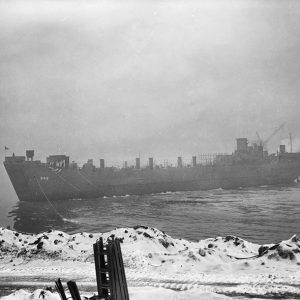calsfoundation@cals.org
USS Johnson County (LST-849)
The USS Johnson County (LST-849) was a tank landing ship constructed in 1944 for the U.S. Navy that saw service in the Pacific during World War II and the occupation of Japan. It was designated the USS Johnson County on July 1, 1955, in honor of counties in twelve states, including Arkansas.
LST-849 was one of a class of vessels—called Landing Ship, Tank—created to carry tanks, wheeled and tracked vehicles, artillery, construction equipment, and supplies during military operations along coastal areas. Called “Large Slow Targets” by their crews, they were designed as shallow-draft vessels; when carrying a 500-ton load, LST 849 drew only three feet eleven inches forward and nine feet ten inches aft. They carried pontoons amidships that could be used to create causeways when they had to debark their cargos from deeper water, but they were capable of dropping their forward ramps directly onto a beach.
The vessel’s keel was laid down on November 10, 1944, by the American Bridge Company of Ambridge, Pennsylvania, and the ship was christened and launched on December 20, 1944. LST-849 weighed 1,625 tons, measured 328 feet long and fifty feet wide, and could reach speeds of 11.6 knots. It carried a crew of thirteen officers and 104 men, and could transport sixteen officers and 147 soldiers. LST-849 was armed with two twin 40mm guns, four single 40mm guns, and twelve single 20mm guns to fend off attacking aircraft. It was commissioned at New Orleans, Louisiana, on January 25, 1945, under the command of Lieutenant Emil C. Farkas.
LST-849 had its shakedown cruise (a test of the ship’s performance) off Florida, then went to New Orleans for a load of construction materials, leaving there on March 2, 1945, and dropping the supplies at Guam on May 6. It sailed to Saipan on May 17 and joined a convoy of LSTs for the attack on Okinawa on May 26. On May 29, LST 849 engaged a Japanese torpedo bomber in combat, shooting down the enemy aircraft. It transported supplies to Okinawa throughout the campaign to take the island.
After Japan surrendered, LST-849 carried troops and gear from Okinawa and the Philippines to Yokohama and Tokyo for the occupation forces. It departed Tokyo on October 28 and picked up a load of troops at Guam, delivering them to Pearl Harbor on November 7, and then sailed back to the United States, arriving at San Diego, California, on December 15. It earned one battle star for service during World War II.
In mid-January 1946, the vessel sailed to Astoria, Oregon, then to Vancouver, Washington, where it was decommissioned on June 13, 1946, and assigned to the Pacific Reserve Fleet. It was designated the USS Johnson County on July 1, 1955.
The Johnson County was struck from the navy list in January 1959 and transferred to the Korean navy, where it served as the ROKS Wi Pong (LST-812), later designated LST-676. The vessel later went on display at the Jinpo Maritime Theme Park at Gunsan, South Korea.
For additional information:
“LST 849 Johnson County.” https://www.hazegray.org/danfs/amphib/lst849.htm (accessed June 13, 2018).
Rottman, Gordon L. Landing Ship, Tank (LST) 1942–2002. Oxford, UK: Osprey Publishing Co., 2005.
“USS Johnson County (LST-849).” NavSource Online. http://www.navsource.org/archives/10/16/160849.htm (accessed June 13, 2018).
Mark K. Christ
Little Rock, Arkansas
 Military
Military World War II through the Faubus Era, 1941 through 1967
World War II through the Faubus Era, 1941 through 1967 USS Johnson County
USS Johnson County 



Comments
No comments on this entry yet.